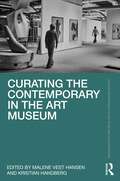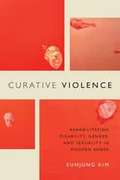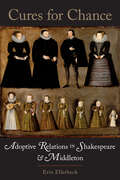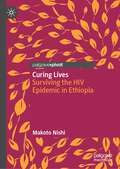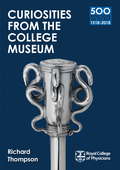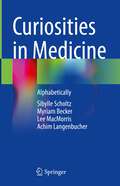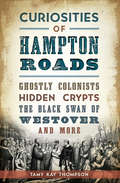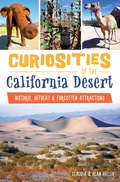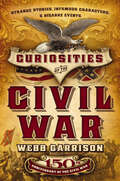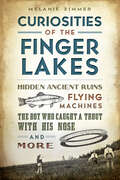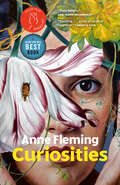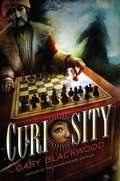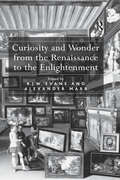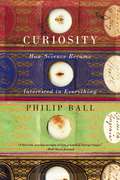- Table View
- List View
Curating the Contemporary in the Art Museum (Routledge Research in Art Museums and Exhibitions)
by Malene Vest HansenCurating the Contemporary in the Art Museum investigates the art museum as a space where the contemporary is staged – in exhibitions, collecting practices, communication, and policies. Curating the Contemporary in the Art Museum traces the art museum back to the postwar era. Including contributions by established and emerging art historians, academics and curators, the book proposes that the art museum is engaged in the contemporary in a double sense: it (re)presents contemporary art, while the contemporary condition itself also has a significant impact on art and the museum that houses it. Presenting a diverse range of international cases of exhibitions and curatorial practices, which hail primarily from Europe and Scandinavia, the essays examine the politics of staging “national”, “international”, and “global” framings of modernism, as well as the new public spaces shaped in digital practices and changing political frameworks. The book investigates both the seminal and the unknown exhibitions and institutions that created contemporary art as we know it today. Curating the Contemporary in the Art Museum provides a historical perspective on the museum of contemporary art. It constitutes a step towards differencing the canon of modernist and contemporary art and a more complex understanding of the politics of curating the contemporary in the art museum, why it will be of interest to academics and students engaged in the study of museums, curating, exhibitions, and art history.
Curating the Enlightenment: Johann Daniel Major and the Experimental Century
by Vera KellerHow did the research universities of the Enlightenment come into being? And what debt do they owe to scholars of the previous era? Focusing on the career of German polymath Johann Daniel Major (1634–93), Curating the Enlightenment uncovers how late seventeenth-century scholars crafted the research university as a haven for critical inquiry in defiance of political and economic pressures. Abandoning the surety of established intellectual practice, this 'experimental century' saw Major and his peers reshaping fragments of knowledge into new perspectives. Across new disciplines, from experimental philosophy to archaeology and museology, they reexamined what knowledge was, who it was for, and how it was to be stored, managed, accessed, judged, and transformed. Although later typecast as Baroque obstacles to be overcome by the Enlightenment, these academics arranged knowledge in dynamic infrastructures that encouraged its further advancement in later generations, including our own. This study examines these seventeenth-century practices as part of a continuous intellectual tradition and reconceptualizes our understanding of the Enlightenment.
Curative Violence: Rehabilitating Disability, Gender, and Sexuality in Modern Korea
by Eunjung KimIn Curative Violence Eunjung Kim examines what the social and material investment in curing illnesses and disabilities tells us about the relationship between disability and Korean nationalism. Kim uses the concept of curative violence to question the representation of cure as a universal good and to understand how nonmedical and medical cures come with violent effects that are not only symbolic but also physical. Writing disability theory in a transnational context, Kim tracks the shifts from the 1930s to the present in the ways that disabled bodies and narratives of cure have been represented in Korean folktales, novels, visual culture, media accounts, policies, and activism. Whether analyzing eugenics, the management of Hansen's disease, discourses on disabled people's sexuality, violence against disabled women, or rethinking the use of disabled people as a metaphor for life under Japanese colonial rule or under the U.S. military occupation, Kim shows how the possibility of life with disability that is free from violence depends on the creation of a space and time where cure is seen as a negotiation rather than a necessity.
Curdle Creek: From the Women's Prize-longlisted author of Remembered
by Yvonne Battle-FeltonWelcome to Curdle Creek. We're dying to make you feel at home.Osira, a forty-five-year-old widow, is an obedient follower of the strict conventions of Curdle Creek, an all-Black town in rural America governed by a tradition of ominous rituals designed to keep the residents safe.Curdle Creek has one particularly strict policy: one in, one out.And one day, it is Osira's turn.Forced into the great unknown. The sinister reality of her birthplace unravels around her. As she comes face-to-face with those she believed were lost, Osira must reckon with all she has ever been told and confront the insidious cruelties of inheritance.
Curdle Creek: From the Women's Prize-longlisted author of Remembered
by Yvonne Battle-FeltonWelcome to Curdle Creek. We're dying to make you feel at home.Osira, a forty-five-year-old widow, is an obedient follower of the strict conventions of Curdle Creek, an all-Black town in rural America governed by a tradition of ominous rituals designed to keep the residents safe.Curdle Creek has one particularly strict policy: one in, one out.And one day, it is Osira's turn.Forced into the great unknown. The sinister reality of her birthplace unravels around her. As she comes face-to-face with those she believed were lost, Osira must reckon with all she has ever been told and confront the insidious cruelties of inheritance.
Curepedia: An immersive and beautifully designed A-Z biography of The Cure
by Simon PriceA Rough Trade Book of the Year A Guardian Music Book of the Year 'Beautifully written and meticulously researched' Classic Pop'[An] all-encompassing repository of Cure wisdom' Record CollectorThe Cure are indisputable titans of alternative rock. Recognisable as much for their iconic aesthetic, videos and artwork as for the lyrical and musical genius of Robert Smith, The Cure's work remains hugely influential on contemporary pop culture. It reverberates through fans of all generations worldwide and through genres ranging from emo to goth, industrial to indie rock.In this fully updated edition of Curepedia, Simon Price sifts through the facts, the myths and the tall tales around The Cure, their recording history and epic tours, to deliver a uniquely kaleidoscopic portrait of the legendary band and a book that has been praised as the definitive document and account of their remarkable career.'An extraordinary piece of work' Elis James'A pleasure to study and absorb - highly recommended' Tim Burgess
Cures for Chance: Adoptive Relations in Shakespeare and Middleton
by Erin EllerbeckAdoption allows families to modify, either overtly or covertly, what is considered to be the natural order. Cures for Chance explores how early modern English theatre questioned the inevitability of the biological family and proposed new models of familial structure, financial inheritance, and gendered familial authority. Because the practice of adoption circumvents sexual reproduction, its portrayal obliges audiences to reconsider ideas of nature and kinship. This study elucidates the ways in which adoptive familial relations were defined, described, and envisioned on stage, particularly in the works of Shakespeare and Middleton. In the plays in question, families and individual characters create, alter, and manage familial relations. Throughout Cures for Chance, adoption is considered in the broader socioeconomic and political climate of the period. Literary works and a wide range of other early modern texts – including treatises on horticulture and natural history and household and conduct manuals – are analysed in their historical and cultural contexts. Erin Ellerbeck argues that dramatic representations of adoption test conventional notions of family by rendering the family unit a social construction rather than a biological certainty, and that in doing so, they evoke the alteration of nature by human hands that was already pervasive at the time.
Curfewed Night: One Kashmiri Journalist's Frontline Account of Life, Love, and War in His Homeland
by Basharat PeerBasharat Peer's powerful memoir about growing up in war-torn Kashmir.
Curing Lives: Surviving the HIV Epidemic in Ethiopia
by Makoto NishiThis is a book about life during the HIV epidemic in Ethiopia, and seeks to understand how and why the global effort to achieve universal HIV treatment has shifted away from its initial focus on the excessive human suffering precipitated by the epidemic. When antiretroviral drugs became available in Ethiopia, they emerged as powerful agents of change: not only did they cure individuals, they also helped people overcome their fear of – and break the silence around – AIDS, while healing the social ruptures caused by the epidemic. Nevertheless, as this book argues, the very same agents have silently “reversed” these changes over the course of the past decade. These reversals have dissolved connections, re-incurred invisible social fissures, and allowed a large majority of people to stay indifferent to the suffering of individuals whose lives remain vulnerable under the current treatment regime. This whole process is a product of neoliberal global health interventions that determine which lives are worthy or unworthy of investment. This book will interest scholars of biopolitics and public health, those who study the developing world, and those interested in how pandemic interventions alter the lives of many.
Curio: The Prequel To Curio
by Evangeline DenmarkCurio, written by Evangeline Denmark, is the story of Grey Haward’s struggles to keep her friends and family safe from their totalitarian government while she’s at home, and from afar. After her friend Whit is taken by a patrol for breaking curfew, Grey is willing to give him her ration of the potion that allows citizens to digest their food, believing she is like her grandfather and father, who don’t need the potion. After being accused of ration dealing, Grey is on the run and becomes trapped in Curio City with the upper-class "Porcies" and ragged, lower-class clockwork people. She is befriended by another trapped human, Blaise, and they must escape together, or the porcelain Lord Blueboy will try to take her power of being unbreakable by force. Grey needs to return to her own world before her friends and family lose their lives.
Curiosities from the College Museum (500 Reflections on the RCP, 1518-2018 #5)
by Richard ThompsonThe Royal College of Physicians celebrates its 500th anniversary in 2018, and to observe this landmark is publishing this series of ten books. Each of the books focuses on fifty themed elements that have contributed to making the RCP what it is today, together adding up to 500 reflections on 500 years. Some of the people, ideas, objects and manuscripts featured are directly connected to the College, while others have had an influence that can still be felt in its work.This fifth book in the series is a celebration of 50 fascinating objects in the Royal College's museum and collections.
Curiosities in Medicine: Alphabetically
by Sibylle Scholtz Myriam Becker Lee MacMorris Achim LangenbucherThis anthology is devoted to the curious side of Medical History. Carl Sagan said: ”You have to know the past to understand the present.” This collection of 80 short stories, written by experts in the field, inspires curiosity and provides a detailed look at the History of Medicine. It investigates many topics, including ancient Egyptian knowledge, the fundamental importance of toothache and how it birthed Anesthesia, and why and when women were allowed to run marathons. The authors report on the background of rubber gloves, the stethoscope and the intraocular lens. Historically important biographies are included, such as those of Arthur Conan Doyle, Napoleon Bonaparte and Claude Monet. The book is relevant for those interested in Medicine and its curious history.
Curiosities of Central New York
by Melanie ZimmerThe people of Central New York know there's something different--perhaps strange--in the air. Across this vast and often wild region, history and lore are remarkably and markedly unusual. Ancient Iroquois mystical traditions still infuse the landscape with a sense of the otherworldly, and for some, witchcraft was a constant fear throughout the nineteenth century. Monsters and even fairies roam the region, frightening or delighting those who say they have encountered them. Visit the world's smallest church in Oneida and North America's only Tibetan monastery, Namgyal, in Ithaca. Join local folklorist Melanie Zimmer as she explores the curiosities of Central New York.
Curiosities of Elmira: The Last Labrador Duck, Professor Smokeball, the Great Female Crime Spree & More
by Kelli L. HugginsLong known as the "Queen City" of New York's Southern Tier, Elmira has a colorful history to live up to that name. Strange events and offbeat characters populate the city's past. Eldridge Park once had a violent bear pit. The mysterious extinction of the Labrador Duck still baffles researchers today. Inventor Henry Clum, forgotten in time, was a pioneer of meteorology. From the bright lights of the city's lost vaudeville stages to the dark corners of the criminal underworld, Elmirans have found fame and infamy. Author Kelli Huggins takes readers on an immersive journey into the curious and unique past of Elmira.
Curiosities of Hampton Roads: Ghostly Colonists, Hidden Crypts, the Black Swan of Westover, and More
by Tamy Kay ThompsonFacts and photos highlighting the haunting side of Virginia&’s Tidewater . . . The history of Hampton Roads is as deep as the waters that surround it. From some of the first settlers in the New World to the formation of the nation, Virginia&’s Tidewater is rich in curious tales of legends and lore. In the Southside, the famed pirate Blackbeard was beheaded by Captain Maynard of Hampton. Captain John Smith was a part of the first governing body in America formed in Jamestown. The nation&’s oldest mental institution still stands in Williamsburg. Staff and guests at Boxwood Inn in Newport News have reported hauntings from a former owner and other eerie occurrences. In this offbeat travel guide, author Tamy Kay Thompson covers these stories and more as she takes readers on a journey through the always entertaining past of Hampton Roads.
Curiosities of the California Desert: Historic, Offbeat & Forgotten Attractions
by Claudia HellerOne might not expect to find much in the middle of California's hot, dry deserts. But to the curious explorer, they're scattered with strange and extraordinary sights. On old Route 66, the desert traveler can find quirky roadside art and mementos left by motorists. In the El Paso Mountains of the Mojave, the daring adventurer can crawl through a tunnel that was hand dug by an old prospector named Burro Schmidt. In Landers, the weary wanderer can enjoy a rejuvenating "sound bath" in an acoustically perfect dome supposedly designed by aliens. From astounding natural wonders to remnants of ancient civilizations and the Wild West, discover treasures of history, puzzling mystery and uncommon eccentricity alongside seasoned road trippers Alan and Claudia Heller.
Curiosities of the Civil War: Strange Stories, Infamous Characters & Bizarre Events
by Webb GarrisonCivil War buffs, be warned: Webb Garrison&’s Curiosities of the Civil War may catch you off guard.Packed with obscurities and bizarre anecdotes, it spills over with specifics you&’ve likely never heard. Debated, reenacted, and analyzed, the Civil War has been the subject of countless books, films, and scholarly research—many of them quite repetitious. This nuanced perspective on the war provides a glimpse beyond the bloody battles, casualties, and political conflict. You'll discover:The first sitting president to be exposed to enemy fireWhat badgers, pigeons, and bear cubs had in common during the warWhich of Stonewall Jackson&’s limbs received its own proper burialThe turtle-shaped ship designed to douse its opponents with boiling waterWhich Confederate general was responsible for introducing camels to the SouthwestThis cache of peculiar characters and stories will deepen your understanding of the war and the people who engaged in it.
Curiosities of the Confederate Capital: Untold Richmond Stories of the Spectacular, Tragic, and Bizarre
by Brian BurnsUncover the secrets of the River City&’s Confederate past. In the early days of the Civil War, Richmond was declared the capital of the Confederacy, and until now, countless stories from its tenure as the Southern headquarters have remained buried. Mary E. Walker, a Union doctor and feminist, was once held captive in the city for refusing to wear proper women&’s clothing. A coffee substitute factory exploded under intriguing circumstances. Many Confederate soldiers, when in the trenches of battle, thumbed through the pages of Hugo&’s Les Miserables. Author Brian Burns reveals these and many more curious tales of Civil War Richmond.
Curiosities of the Finger Lakes: Hidden Ancient Ruins, Flying Machines, the Boy Who Caught a Trout with His Nose and More
by Melanie ZimmerThe Finger Lakes region is known for its beauty, but look carefully and you will discover some of New York's other abundant--and unusual--treasures. The cliffs of Excelsior Glen are scattered with ancient Indian pictographs, and Bluff Point conceals the ruins of an unknown civilization. The wine industry has its own strange stories; discover why one wine producer was banned from using his own name. Among the oddities of the Finger Lakes region are the world's largest pancake, a slice of Susan B. Anthony's seventy-eighth birthday cake and the anecdote of the boy who accidentally caught an eight-pound trout with his nose. Join author Melanie Zimmer and uncover these and other curiosities and strange tales of the Finger Lakes.
Curiosities: A Novel
by Anne Fleming"Curiosities is pure delight. Anne Fleming draws us in so that we feel we are living the characters&’ lives, whether braving the North Atlantic on a sailing ship, or stealing away for a forbidden tryst in the English countryside. And she does it all with a light touch that has the reader dancing through peril and pleasure." —Ann-Marie MacDonald"Curiosities arrives like a little sun from another period to warm the reader with the joy and pleasure of knowledge, even as it illuminates the terrors and confusion that arise from ignorance. Wonders and disasters tumble over fractured lives and loves, but Fleming&’s conjuring of the past alive in our present is so deft and sure it might be witchcraft. I loved this book." —Marina EndicottThis sparkling, genre-bending novel opens with amateur historian Anne, who has a passion for research into the murkier corners of England in the 1600s. In an archive, Anne has stumbled across an obscure memoir, one that hints at an intricate tapestry of secret lives and loves. The full story eventually weaves together five manuscripts, each a different thread in the same strange tale: The Plague descends upon a village, and two children, Joan and Thomasina, are the only survivors. They bond with each other and with "Old Nut," a woman who lives in the forest nearby. But when relatives return, Old Nut is accused of witchcraft and condemned to death. Joan is hired as a maid to well-educated Lady Margaret Long—and, being lively and curious, soon becomes a beloved companion. Thomasina is sent on a perilous voyage to Virginia, where she adopts boys' clothing and navigates life as a male. Years later, Tom and Joan find each other and fall in love—but are discovered, naked, by a clergyman. Horrified, he believes there can only be one explanation for Tom's "unmanned" state: Joan is a witch and, like Old Nut years ago, must be tried for sorcery. It falls upon Anne, reading between faded pages and centuries, to uncover the fate of the lovers—and add her own contemporary line of "truth" to this tale from a time when there were no labels for who Tom and Joan might be.
Curiosity
by Gary BlackwoodIntrigue, danger, chess, and a real-life hoax combine in this historical novel from the author of The Shakespeare Stealer Philadelphia, PA, 1835. Rufus, a twelve-year-old chess prodigy, is recruited by a shady showman named Maelzel to secretly operate a mechanical chess player called the Turk. The Turk wows ticket-paying audience members and players, who do not realize that Rufus, the true chess master, is hidden inside the contraption. But Rufus's job working the automaton must be kept secret, and he fears he may never be able to escape his unscrupulous master. And what has happened to the previous operators of the Turk, who seem to disappear as soon as Maelzel no longer needs them? Creeping suspense, plenty of mystery, and cameos from Edgar Allan Poe and P. T. Barnum mark Gary Blackwood's triumphant return to middle grade fiction.
Curiosity Of School,The
by Zander ShermanIt's one thing we all have in common. We've all been to school. But as Zander Sherman shows in this fascinating, often shocking account of institutionalized education, sending your kids off to school was not always normal. In fact, school is a very recent invention. Taking the reader back to 19th-century Prussia, where generals, worried about soldiers' troubling individuality, sought a way to standardize every young man of military age, through to the most controversial debates that swirl around the world about the topic of education today, Sherman tells the often astonishing stories of the men and women-and corporations-that have defined what we have come to think of as both the privilege and the responsibility of being educated. Along the way, we discover that the SAT was invented as an intelligence test designed to allow the state to sterilize "imbeciles," that suicide in the wake of disappointing results in the state university placement exams is the fifth leading cause of death in China, and that commercialized higher education seduces students into debt as cynically as credit card companies do. Provocative, entertaining-and even educational-The Curiosity of School lays bare the forces that shape the institution that shapes all of us.
Curiosity and Wonder from the Renaissance to the Enlightenment
by R.J.W. Evans'Curiosity' and 'wonder' are topics of increasing interest and importance to Renaissance and Enlightenment historians. Conspicuous in a host of disciplines from history of science and technology to history of art, literature, and society, both have assumed a prominent place in studies of the Early Modern period. This volume brings together an international group of scholars to investigate the various manifestations of, and relationships between, 'curiosity' and 'wonder' from the 16th to the 18th centuries. Focused case studies on texts, objects and individuals explore the multifaceted natures of these themes, highlighting the intense fascination and continuing scrutiny to which each has been subjected over three centuries. From instances of curiosity in New World exploration to the natural wonders of 18th-century Italy, Curiosity and Wonder from the Renaissance to the Enlightenment locates its subjects in a broad geographical and disciplinary terrain. Taken together, the essays presented here construct a detailed picture of two complex themes, demonstrating the extent to which both have been transformed and reconstituted, often with dramatic results.
Curiosity: How Science Became Interested in Everything
by Philip BallWith the recent landing of the Mars rover Curiosity, it seems safe to assume that the idea of being curious is alive and well in modern science—that it’s not merely encouraged but is seen as an essential component of the scientific mission. Yet there was a time when curiosity was condemned. Neither Pandora nor Eve could resist the dangerous allure of unanswered questions, and all knowledge wasn’t equal—for millennia it was believed that there were some things we should not try to know. In the late sixteenth century this attitude began to change dramatically, and in Curiosity:How Science Became Interested in Everything, Philip Ball investigates how curiosity first became sanctioned—when it changed from a vice to a virtue and how it became permissible to ask any and every question about the world. Looking closely at the sixteenth through eighteenth centuries, Ball vividly brings to life the age when modern science began, a time that spans the lives of Galileo and Isaac Newton. In this entertaining and illuminating account of the rise of science as we know it, Ball tells of scientists both legendary and lesser known, from Copernicus and Kepler to Robert Boyle, as well as the inventions and technologies that were inspired by curiosity itself, such as the telescope and the microscope. The so-called Scientific Revolution is often told as a story of great geniuses illuminating the world with flashes of inspiration. But Curiosity reveals a more complex story, in which the liberation—and subsequent taming—of curiosity was linked to magic, religion, literature, travel, trade, and empire. Ball also asks what has become of curiosity today: how it functions in science, how it is spun and packaged for consumption, how well it is being sustained, and how the changing shape of science influences the kinds of questions it may continue to ask. Though proverbial wisdom tell us that it was through curiosity that our innocence was lost, that has not deterred us. Instead, it has been completely the contrary: today we spend vast sums trying to reconstruct the first instants of creation in particle accelerators, out of a pure desire to know. Ball refuses to let us take this desire for granted, and this book is a perfect homage to such an inquisitive attitude.
Curious About Money (Smithsonian)
by Mary E. ReidMoney talks . . . about history!Shells. Coins. Paper bills. Credit cards. Bitcoins. People have used all kinds of objects to buy, sell, or trade. Aren&’t you curious: what is money? Developed with numismatic curators at the Smithsonian, this fascinating book looks at how people, money, and history intersect, right on up to what's current about currency.Penguin-Smithsonian nonfiction: where content meets cool!
